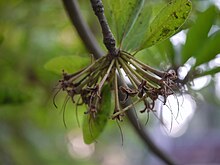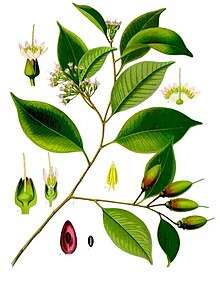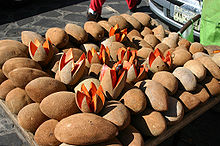Sapote family
| Sapote family | ||||||||||||
|---|---|---|---|---|---|---|---|---|---|---|---|---|

Gutta-percha tree ( Palaquium gutta ), illustration |
||||||||||||
| Systematics | ||||||||||||
|
||||||||||||
| Scientific name | ||||||||||||
| Sapotaceae | ||||||||||||
| Yuss. |
The plant family of sapotaceae (Sapotaceae), also Sapotagewächse or Breiapfelgewächse called, belongs to the order of the heather-like (Ericales) within the flowering plant . Some species are used by humans; the most famous species include the pear apple tree ( Manilkara zapota ) and the star apple ( Chrysophyllum cainito ).
description
Vegetative characteristics
Sapote plants are evergreen or deciduous trees and shrubs . They contain milk juice .
The leaves are alternate, or whorls in spurs disposed summarized. The leaves consist of a petiole and a leaf blade. The petiole has downward-running channels or hollows that form wings on top. The simple leaf blade is leathery, pinnate, shiny on top and mostly silk-haired on the underside. The leaf margin is usually entire, rarely serrated. The stomata are mostly anomocytic or less often paracytic. If Stipules are present, they fall off quickly.
Generative characteristics
The flowers rarely sit individually, usually grouped in lateral, very differently structured inflorescences . The radial symmetry flowers are often four or five-fold, rarely multiple and they are usually hermaphroditic or, less often, unisexual. The mostly four to eight (two to eleven) sepals are free to fused and there is either a circle with four to six or two circles with two to four sepals each. The usually four to eight (up to rarely nine to 18) petals are fused; the crown lobes can be divided. The flowers have one to three stamen circles with usually six times as many stamens as petals. Often one or two circles are reduced to staminodes or are completely absent. In the flowers there are usually three to twelve (one to 30) carpels , which are fused to an upper ovary with as many compartments as carpels. The pen ending in a capitate or slightly lobed stigma. There is a nectar discus .
Usually berries , sometimes stone fruits or capsule fruits with one to ten seeds are formed. The large seeds are brown to black and shiny. If there is an endosperm , it is oily.
The basic chromosome numbers are x = 7 and 9 to 13.









Systematics and distribution
They have a pantropical distribution. The origin of the Sapotaceae family is probably around 100 million years ago in Southeast Asia . Pollen finds from the Paleocene in Europe and in the early Eocene (about 50 million years before present) in Europe and North America show that this family used to have a much wider distribution.
The Sapotaceae family was published in 1789 by Antoine Laurent de Jussieu as "Sapotae" in Genera Plantarum , 151. The type genus is Sapota Mill. Which is now a synonym of Manilkara Adans. is. Synonyms for Sapotaceae Juss. are: Achradaceae Vest , Boerlagellaceae HJLam , Bumeliaceae Barnhart , Sarcospermataceae HJLam nom. cons. This family was formerly in the Sapotales Hook orders . f. , Ebenales Engl. And is today incorporated into the order of the Ericales.
The Sapotaceae Juss family . is divided into three subfamilies with 53 genera and around 1100 to more than 1200 species:
- Subfamily Chrysophylloideae Luersson : It is pantropically distributed and is divided into two tribes with 25 to 26 genera and about 550 species:
- Tribe Chrysophylleae: It contains about 19 genera:
-
Aubregrinia Heine : It contains only one species:
- Aubregrinia taiensis (Aubrév. & Pellegr.) Heine : It occurs from Liberia to Ghana .
-
Breviea Aubrév. & Pellegr. : It contains only one type:
- Breviea sericea Aubrév. & Pellegr. : It occurs from the Ivory Coast to west-central tropical Africa.
- Capurodendron Aubrév. : The approximately 23 species occur only in Madagascar .
-
Chrysophyllum L .: It contains about 80 species found in the tropics and subtropics, including:
- Chrysophyllum januariense Eichler : It occurred in Brazil.
- Chrysophyllum oliviforme L .: Central America, Caribbean
- Chrysophyllum cainito L .: Central America, Caribbean.
- Chromolucuma Ducke : The approximately five species occur from Costa Rica to northern South America and Brazil.
- Delpydora Pierre : The two species are common in West Africa and in west-central tropical Africa.
- Ecclinusa Mart. : The approximately twelve species are distributed in Panama and in tropical South America.
- Elaeoluma Baill. : The four species are common in Costa Rica, Panama and tropical South America.
- Englerophytum K. Krause : The 19 or so species are distributed in tropical and southern Africa.
- Leptostylis Benth. : The eight or so species occur only in New Caledonia . The genus is also used as a synonym for Pycnandra Benth. posed.
- Micropholis (Griseb.) Pierre : The 38 species are distributed from southern Mexico to tropical South America.
- Pichonia Pierre : The approximately 12 species occur from the Moluccas to New Caledonia.
-
Pouteria Aubl. (Syn .: Achradelpha O.F.Cook , Albertisiella Pierre ex Aubrév. , Aningeria Aubrév. & Pellegr. , Barylucuma Ducke , Beauvisagea Pierre , Beccariella Pierre , Beccarimnia Pierre ex Coord. , Blabea Baehni , Blabeia Baehni , Boerlagella Cogn. , Bureavella Pierre , Calocarpum Pierre , Calospermum Pierre , Caramuri Aubrév. & Pellegr. , Chaetocarpus Schreb. , Daphniluma Baill. , Discoluma Baill. , Dithecoluma Baill. , Eglerodendron Aubrév. & Pellegr. , Engler Ella Pierre , Eremoluma Baill. , Fontbrunea Pierre , Franchetella Pierre , Gayella Pierre , Gomphiluma Baill. , Guapeba Gomes , Hormogyne A.DC. , Ichthyophora Baehni , Iteiluma Baill. , Kraus Ella H.J.Lam , Krug Ella Pierre , Labatia Sw. , Leioluma Baill. , lucuma Molina , Maesoluma Baill. , Malacantha Pierre , Microluma Baill. , Myrsiniluma Baill. , Myrtiluma Baill. , Nemaluma Baill. , Neolabatia Aubrév. , Neoxythece Aubrév. & Pellegr. , Ochroluma Baill. , Oxythece Miq. , Paralabatia Pierre , Peteniodendron Lundell , Peuceluma Baill. , Pire sodendron Aubrév. ex Le Thomas , Planchonella Pierre , Pleioluma Baill. , Podoluma Baill. , Poissonella Pierre , Prozetia Neck. , nom. inval., Pseudocladia Pierre , Pseudolabatia Aubrév. & Pellegr. , Pseudoxythece Aubrév. , Pyriluma (Baill.) Aubrév. , Radlkoferella Pierre , Richardella Pierre , Sandwithiodoxa Aubrév. & Pellegr. , Sersalisia R.Br. , Siderocarpus Pierre , Syzygiopsis Ducke , Urbanella Pierre , Van-royena Aubrév. , Woikoia Baehni , Wokoia Baehni ): It contains 200 to 305 species. They occur in the tropics and subtropics. Including:
- Pouteria campechiana (Kunth) Baehni
- Lucuma ( Pouteria lucuma (Ruiz & Pav.) Kuntze )
- Great sapote ( Pouteria sapota (Jacq.) HE Moore & Stearn )
-
Pradosia Liais : The approximately 25 species occur in tropical America and in west-central tropical Africa. Including:
- Pradosia surinamensis (Eyma) TDPenn. : Northern Brazil, Guyanas and Venezuela.
- Pycnandra Benth. : The approximately 59 species occur only in New Caledonia.
- Sarcaulus Radlk. : The five species occur in Costa Rica, Panama and tropical South America.
-
Synsepalum (A.DC.) Daniell : It contains about 36 species found in tropical Africa, including:
- Miracle berry ( Synsepalum dulcificum (Schumach. & Thonn.) Daniell )
- Xantolis Raf. : The approximately 14 species are distributed from the eastern Himalayas to the Philippines .
-
Aubregrinia Heine : It contains only one species:
- Tribus Omphalocarpeae: It contains about four genera
- Magodendron Vink : The two species occur in New Guinea .
- Omphalocarpum P.Beauv. : It contains about 27 species found in western Africa and west-central tropical Africa.
- Tridesmostemon Engl .: The two types are common in western Africa and in west-central tropical Africa.
-
Tsebona Capuron : It contains only one type:
- Tsebona macrantha Capuron : It occurs in eastern Madagascar.
- Tribe Chrysophylleae: It contains about 19 genera:
- Not classified in a tribe:
-
Diploon Cronquist : It contains only one species:
- Diploon cuspidatum (Hoehne) Cronquist : It is widespread in tropical South America.
-
Neohemsleya T.D.Penn. : It contains only one type:
- Neohemsleya usambarensis T.D.Penn. : This endemic occurs only in the Usambara Mountains in Tanzania .
- Niemeyera F. Muell. : The three types occur in eastern Australia.
-
Diploon Cronquist : It contains only one species:
- Not classified in a tribe:
- Subfamily Sarcospermatoideae Swenson & Anderberg : It contains only one genus in Eastern Asia and the Malay Archipelago :
- Sarcosperma Hook. f. : There are eleven evergreen tree species that occur from Sikkim to southern China and Malesia .
- Subfamily Sapotoideae Eaton : Is divided into three tribes with 27 genera and 543 species. Overall, they have a pantropical distribution: around 300 species are native to the Indo-Pacific region, around 150 species in Africa and around 75 species in the New World.
- Tribus Mimusopeae: With about 17 genera:
-
Autranella A. Chev. : It contains only one type:
- Autranella congolensis (De Wild.) A. Chev. : It occurs from Nigeria to west-central tropical Africa.
-
Baillonella Pierre : It contains only one species:
- Baillonella toxisperma Pierre : It occurs from Nigeria to west-central tropical Africa.
- Eberhardtia Lecomte : The threeor sospecies are common in southern China, Laos and Vietnam.
- Faucherea Lecomte : The eleven or so species only occur in Madagascar.
- Gluema Aubrév. & Pellegr. : There are about two species from Liberia to Gabon .
-
Inhambanella (Engl.) Dubard : The two species occur in Liberia, in the Ivory Coast and from Kenya to southern Africa.
- Inhambanella henriquesii (Engl. & Warb.) Dubard : East to South Africa
- Labourdonnaisia Bojer : The seven species occur in Madagascar, Mauritius and Réunion .
- Labramia A.DC. : The nine or so species occur only in Madagascar.
- Lecomtedoxa (Pierre ex Engl.) Dubard : The six or so species occur in west-central tropical Africa.
-
Letestua Lecomte : it contains only one species:
- Letestua durissima (A.Chev.) Lecomte : It occurs in west-central tropical Africa.
- Manilkara Adans. (Syn .: Sapota Mill. ): The approximately 80 species are widespread in the tropics and subtropics.
-
Mimusops L .: The 44 to 50 species are widespread in the tropics and subtropics of the Old World. Including:
- Mimusops elengi L .; it is cultivated for its fragrant flowers. It originally occurs from southern India to Vanuatu .
- Neolemonniera Heine : The three or so species are distributed from western Africa to western-central tropical Africa.
-
Northia Hook. f. : It contains only one type:
- Northia seychellana Hook. : It only occurs in the Seychelles .
-
Tieghemella Pierre : The roughly two species occur from West Africa to west-central tropical Africa.
- Tieghemella heckelii (A.Chev.) Pierre ex Dubard : From West Africa
-
Vitellaria C.F. Gaertn. (Syn .: Butyrospermum Kotschy ): It contains only one species:
- Karité tree , also shea nut tree or shea butter tree ( Vitellaria paradoxa C.F.Gaertn. , Syn .: Bassia parkii G.Don , Butyrospermum paradoxum (CFGaertn.) Hepper , Butyrospermum parkii (G.Don) Kotschy ): It comes in two subspecies from western tropical Africa to to Sudan , Uganda and Ethiopia.
- Vitellariopsis Baill. ex Dubard : The approximately five species occur from tropical East Africa to southern Africa.
-
Autranella A. Chev. : It contains only one type:
- Tribus Isonandreae: With about seven genera:
- Aulandra H.J.Lam : The three species occur on Borneo .
- Burckella Pierre : The approximately 13 species are distributed from the Moluccas to the islands of the southwestern Pacific .
- Diploknema Pierre : The seven species are common in tropical-subtropical Asia.
- Isonandra Wight : The ten or so species occur in India, Sri Lanka and western Malesia.
- Madhuca Buch.-Ham. ex JFGmel. : The approximately 115 species occur in China and tropical Asia.
- Gutta-percha trees ( Palaquium Blanco ): The approximately 120 species come from tropical and subtropical Asia to the islands in the western Pacific.
- Payena A.DC. : The 20 or so species are common in Malesia and Indochina .
- Tribus Sideroxyleae: The only two to three genera with around 80 species have a disjoint area in the tropics. There are four species on the African continent, six on Madagascar , eight on the Mascarene , three on the other islands of the Indian Ocean, two on Macaronesia , three in Southeast Asia , nine in the southern USA , and 28 in Central America including Mexico Species, on the Caribbean islands 24 species, in South America three species and on the Pacific islands three species. The fleshy fruits are mainly eaten by primates and birds and the seeds are spread in this way. The transport of seeds by birds explains the widespread distribution of some taxa on islands.
-
Argania Roem. & Schult. : It contains only one type:
- Argan tree ( Argania spinosa (L.) Skeels ; Syn .: Sideroxylon spinosum L. ): This species is threatened with extinction and only occurs in southern Morocco in Souss. It is also put to Sideroxylon by some authors .
-
Sideroxylon L. (Syn .: Nesoluma Baill. ): The approximately 80 species are widespread from tropical and subtropical Africa to China, on the islands of the Pacific and from the USA to South America; among them for example:
- Calvaria tree ( Sideroxylon grandiflorum A.DC. ): It occurs only in Mauritius .
- Milk bush ( Sideroxylon inerme L. ): This species occurs from Somalia to southern Africa, on Aldabra and Juan de Nova .
- Sideroxylon mirmulans R.Br. : It thrives in the laurel forest on Madeira .
-
Argania Roem. & Schult. : It contains only one type:
- Tribus Mimusopeae: With about 17 genera:
use

The sapodilla ( Manilkara zapota ) delivers the chicle one of the most important raw materials of the chewing gum industry. The “Mamey” fruits from Pouteria sapota and Manilkara zapota can be used in desserts and drinks. The star apple tree ( Chrysophyllum cainito ) provides edible fruits and is planted as an ornamental tree. The dried milky sap of the gutta-percha tree ( Palaquium gutta ), the gutta-percha , found and is still used in many ways today. The miracle berry , also called miracle fruit, from Synsepalum dulcificum is used as a sweetener. The shea tree ( Vitellaria paradoxa ), also called shea nut tree, shea butter tree or African butter tree, is used in many ways. The argan tree ( Argania spinosa ) is grown for oil production.
More pictures
Star apple tree ( Chrysophyllum cainito ):
swell
- The Sapotaceae family on the AP website. (Sections systematics and description)
- The Sapotaceae family at DELTA by L. Watson and MJ Dallwitz. (Section description)
- Shugang Li, Terence Dale Pennington: Sapotaceae. , P. 205 - online with the same text as the printed work , In: Wu Zheng-yi, Peter H. Raven (Ed.): Flora of China. Volume 15: Myrsinaceae through Loganiaceae , Science Press and Missouri Botanical Garden Press, Beijing and St. Louis, 1996. ISBN 0-915279-37-1 (section description)
- Wayne J. Elisens, R. David Whetstone, Richard P. Wunderlin: Sapotaceae , p. 232 - online with the same text as the printed work , In: Flora of North America Editorial Committee (ed.): Flora of North America North of Mexico. Volume 8: Paeoniaceae to Ericaceae , Oxford University Press, New York and Oxford, 2009. ISBN 978-0-19-534026-6 (section description)
- Frances Kristina Kupicha: Sapotaceae in Flora Zambesiaca , Volume 7, 1983: online.
- Arne A. Anderberg, Ulf Swenson: Evolutionary lineages in Sapotaceae (Ericales): A cladistic analysis based on ndhF sequence data. In: International Journal of Plant Sciences , Volume 164 (5), 2003, pp. 763-773.
- Ulf Swenson, Arne A. Anderberg: Phylogeny, character evolution, and classification of Sapotaceae (Ericales). In: Cladistics , Volume 21, Issue 2, 2005, pp. 101-130.
- Igor V. Bartish, Ulf Swenson, Jérôme Munzinger, Arne A. Anderberg: Phylogenetic relationships among New Caledonian Sapotaceae (Ericales): molecular evidence for generic polyphyly and repeated dispersal. In: American Journal of Botany. Volume 92, 2005, pp. 667-673.
Individual evidence
- ↑ a b c Sapotaceae in the Germplasm Resources Information Network (GRIN), USDA , ARS , National Genetic Resources Program. National Germplasm Resources Laboratory, Beltsville, Maryland.
- ↑ Ulf Swenson, JE Richardson, Igor V. Bartish: Multi-gene phylogeny of the pantropical subfamily Chrysophylloideae (Sapotaceae): Evidence of generic polyphyly and extensive morphological homoplasy. In: Cladistics. Volume 24, 2008, pp. 1006-1031.
- ↑ a b c d e f g h i j k l m n o p q r s t u v w x y z aa ab ac ad ae af ag ah ai aj ak al am an ao ap aq ar as at au av aw ax ay az ba bb bc Rafaël Govaerts (ed.): Sapotaceae. In: World Checklist of Selected Plant Families (WCSP) - The Board of Trustees of the Royal Botanic Gardens, Kew . Retrieved October 28, 2018.
- ^ A b David John Mabberley: Mabberley's Plant-Book. A portable dictionary of plants, their classification and uses. 3rd edition, Cambridge University Press 2008, ISBN 978-0-521-82071-4 .
- ↑ T. Triono, AHD Brown, JG West, MD Crisp: A phylogeny of Pouteria (Sapotaceae) from Malesia and Australasia. In: Australian Systematic Botany. Volume 20, 2007, pp. 107-118.
- ↑ Ulf Swenson, P. P Lowry II, Jérôme Munzinger, C. Rydin, Igor V. Bartish: Phylogeny and generic limits in the Niemeyera complex of New Caledonian Sapotaceae: Evidence of multiple origins of the anisomerous flower. In: Molecular Phylogenetics and Evolution. Volume 49, 2008, pp. 909-929.
- ↑ Jenny EE Smedmark, Ulf Swenson, Arne A. Anderberg: Accounting for variation of substitution rates through time in Bayesian phylogeny reconstruction of Sapotoideae (Sapotaceae). In: Molecular Phylogenetics and Evolution. Volume 39, 2006, pp. 706-721. online (PDF).
- ↑ Jenny EE Smedmark, Arne A. Anderberg: Boreotropical migration explains hybridization between geographically distant lineages in the pantropical clade Sideroxyleae (Sapotaceae). In: American Journal of Botany. Volume 94, Issue 9, 2007, pp. 1491-1505, online .





